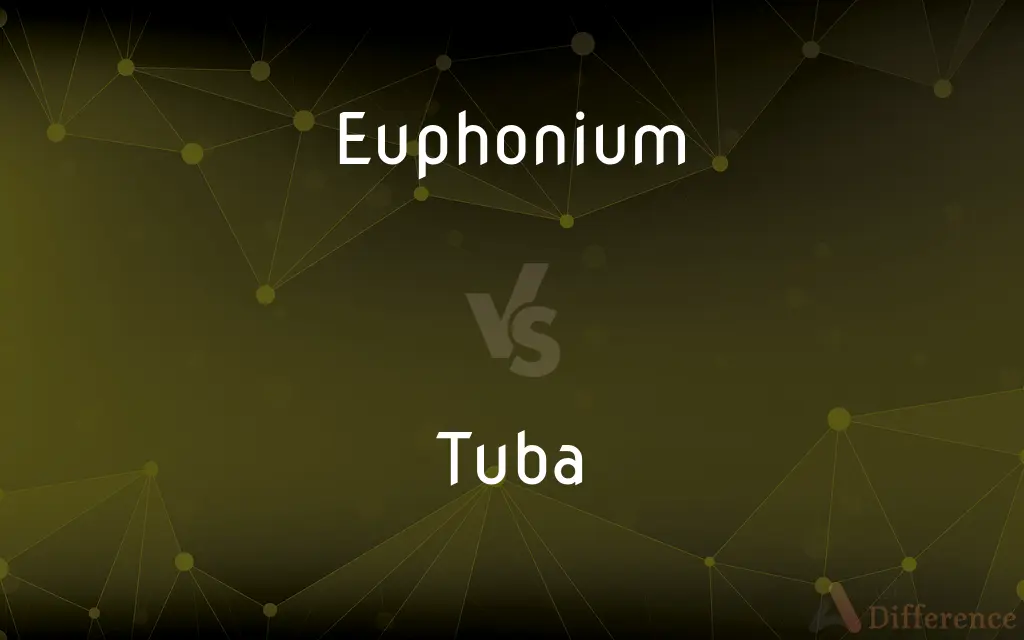Euphonium vs. Tuba — What's the Difference?
Edited by Tayyaba Rehman — By Fiza Rafique — Updated on March 24, 2024
Euphonium and tuba are both brass instruments with deep, rich tones, but euphonium is smaller with mellower sound, often playing higher parts, while tuba is larger, producing the lowest tones in brass ensembles and serving as bass foundation.

Difference Between Euphonium and Tuba
Table of Contents
ADVERTISEMENT
Key Differences
The euphonium and tuba share a family lineage in the brass instrument category, characterized by their conical bores and deep, resonant sounds. On the other hand, the tuba is the largest and lowest-pitched instrument in the brass family, with its primary role being to provide the bass foundation in orchestras, bands, and other musical groups.
The euphonium is often described as having a warm, singing quality to its sound, which is why it is sometimes referred to as the "cello of the brass family." This quality makes it a favorite for solo performances and intricate parts within concert bands. In contrast, the tuba's significant presence and depth of sound anchor the harmonic foundation, supporting the entire range of the ensemble.
While both instruments use a similar range of fingerings and valves to change pitches, the euphonium typically has three or four valves (sometimes five with compensating systems), whereas tubas usually have four to six valves. This difference in valve configurations allows each instrument to explore its respective range and tonal qualities effectively.
In terms of roles within ensembles, the euphonium is more versatile, often taking on both harmonic and melodic responsibilities. The tuba, due to its size and sound, is predominantly used for bass lines and rhythm, although skilled players can also perform solos and more complex parts.
Comparison Chart
Size and Pitch
Smaller and higher-pitched, typically in B♭ or E♭
Largest and lowest-pitched in the brass family
ADVERTISEMENT
Sound Quality
Mellower, lyrical, and suited for melodies
Powerful, broad, and deep, providing bass foundation
Role in Ensembles
Versatile, playing harmony and melody
Provides the bass foundation, supporting all parts
Valve Configuration
Usually 3-4 valves, sometimes 5 with compensating systems
Typically 4-6 valves, depending on the model
Common Uses
Solo performances, concert bands, brass bands
Orchestras, military bands, brass ensembles
Compare with Definitions
Euphonium
Suited for both solo and ensemble playing.
She chose a euphonium for its versatility in solo and group pieces.
Tuba
Can vary in size and pitch, including B♭, C, E♭, and F.
He played a B♭ tuba, the most common type in school bands.
Euphonium
Known for its agility and range in higher registers.
In the concert band, the euphonium's part intertwined with the clarinets.
Tuba
Requires a significant amount of air to play.
Tuba players are known for their lung capacity and breath control.
Euphonium
Can have a compensating system for accurate intonation.
His compensating euphonium allowed for precise pitch control across all registers.
Tuba
Acts as the foundation in brass and orchestral ensembles.
The orchestra's tuba provided a solid bass line throughout the symphony.
Euphonium
A medium-sized brass instrument with a warm, lyrical tone.
The soloist played a haunting melody on the euphonium.
Tuba
The largest and lowest-pitched brass instrument.
The tuba's deep tones resonated through the concert hall.
Euphonium
Often features in brass and military bands.
The euphonium section added depth to the brass band's performance.
Tuba
Often used for bass lines and rhythmic parts.
In jazz bands, the tuba sometimes takes the bass guitar's role.
Euphonium
The euphonium is a medium-sized, 3 or 4-valve, often compensating, conical-bore, tenor-voiced brass instrument that derives its name from the Ancient Greek word εὔφωνος euphōnos, meaning "well-sounding" or "sweet-voiced" (εὖ eu means "well" or "good" and φωνή phōnē means "sound", hence "of good sound"). The euphonium is a valved instrument.
Tuba
The tuba (UK: ; US: ) is the lowest-pitched musical instrument in the brass family. As with all brass instruments, the sound is produced by lip vibration, or a buzz, into a mouthpiece.
Euphonium
A brass instrument similar to the tuba but having a somewhat higher pitch and a mellower sound.
Tuba
A large, valved, brass instrument with a bass pitch.
Euphonium
A valved brass instrument with conical tubing similar in appearance to a tuba but of higher pitch; a sax horn.
Tuba
A reed stop in an organ, having eight-foot pitch.
Euphonium
A bass instrument of the saxhorn family.
Tuba
A large brass musical instrument, usually in the bass range, played through a vibration of the lips upon the mouthpiece and fingering of the keys.
Euphonium
A bass horn (brass wind instrument) that is the tenor of the tuba family
Tuba
A type of Roman military trumpet, distinct from the modern tuba.
Tuba
A large reed stop in organs.
Tuba
A Malayan plant whose roots are a significant source of rotenone, Derris malaccensis.
Tuba
A reddish palm wine made from coconut or nipa sap.
Tuba
(anatomy) A tube or tubular organ.
Tuba
An ancient trumpet.
Tuba
The lowest brass wind instrument
Common Curiosities
How do you choose between playing the euphonium and the tuba?
Choice often depends on personal interest, the desired role in music (melody vs. bass), and physical considerations like lung capacity and size.
Can the euphonium and tuba play the same music?
While they can play similar music, the euphonium is better suited for melodic and agile parts, and the tuba for bass lines and lower registers.
What genres of music are euphoniums and tubas used in?
Both are used in classical, concert band, brass band, and military music, with the tuba also appearing in jazz and marching bands.
What are the key differences between a euphonium and a tuba?
The main differences are size, pitch range, sound quality, and role in ensembles, with the euphonium being smaller, higher-pitched, and more melodic, while the tuba provides the bass foundation.
How does the sound of the euphonium complement the tuba in an ensemble?
The euphonium adds warmth and melody, enhancing the ensemble's middle range, while the tuba provides a deep, resonant foundation.
What makes the euphonium known as the "cello of the brass family"?
Its warm, singing tone and capacity for lyrical, expressive melodies liken it to the cello's role in string sections.
Is the euphonium easier to learn than the tuba?
Ease of learning depends on the individual, but the euphonium might be physically easier for younger students due to its smaller size.
How does the compensating system work in euphoniums?
The compensating system helps correct the pitch in the lower register when multiple valves are pressed, ensuring accurate intonation.
Can tuba and euphonium players switch between instruments?
Many skills are transferable, but each instrument requires specific technique adjustments and practice.
Do euphoniums and tubas require the same mouthpiece?
No, they typically use different mouthpieces suited to their specific size and sound production needs.
Are there different types of tubas?
Yes, tubas come in various sizes and pitches, including B♭, C, E♭, and F, to suit different musical needs and ensembles.
Share Your Discovery

Previous Comparison
Gout vs. Osteoarthritis
Next Comparison
Infectious vs. InfectiveAuthor Spotlight
Written by
Fiza RafiqueFiza Rafique is a skilled content writer at AskDifference.com, where she meticulously refines and enhances written pieces. Drawing from her vast editorial expertise, Fiza ensures clarity, accuracy, and precision in every article. Passionate about language, she continually seeks to elevate the quality of content for readers worldwide.
Edited by
Tayyaba RehmanTayyaba Rehman is a distinguished writer, currently serving as a primary contributor to askdifference.com. As a researcher in semantics and etymology, Tayyaba's passion for the complexity of languages and their distinctions has found a perfect home on the platform. Tayyaba delves into the intricacies of language, distinguishing between commonly confused words and phrases, thereby providing clarity for readers worldwide.














































